|
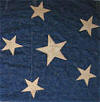 |
The Women's Suffrage Flag
This
fantastic flag, dating from 1912, is the
only known surviving Women's Suffrage
flag in the Stars and Stripes pattern.
Read more about its unique and unusual
history. |
|
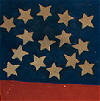 |
A Tale of Two Flags - The Abolitionist
Flag and the Secessionist Flag
Despite
dating from the same era, and being of
the same form of our cherished Stars and
Stripes, these two American flags could
not be more symbolically different in
the ideas they embody. |
|
 |
Learn more
about the great Ship's Flags of the
early 19th century.
These
grand flags, made prior to the American
Civil War, are exceedingly rare and
beautiful examples of our flag in some
of the earliest and rarest star counts.
|
|
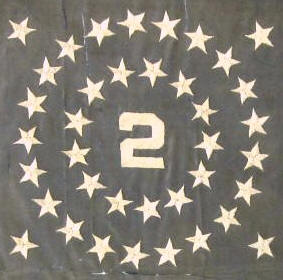 |
Learn more
about American Battle Flags.
Identifying flags used by the United
States Military can sometimes be
challenging, but there are attributes
that many of them have in common that
are good indicators of an American
Battle Flag. |
|
 |
Learn more about the many patterns of 13
Star flags.
13 Star Flags have been
produced throughout our history.
In this single star count, the number of
variations of star patterns is
astonishing. |
|
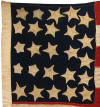 |
Learn more about how Americans update
flags with more stars.
Over time as
new states entered the Union, Americans
added stars to their flags to keep them
updated. |
|
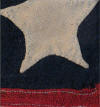 |
Learn more about the fabrics used in
flag construction.
Common materials
used in flag construction include wool
bunting, cotton, linen and silk.
This guide helps with identifying
various fabrics and clues to estimating
their age. |
|
 |
Learn more about "souveniring".
The practice of clipping small pieces of
flags to keep as a souvenir was once
common. See examples and
understand more about this interesting
past practice. |
|
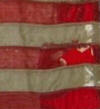 |
Learn more about how Americans care for
and repair their flags.
Flags of the
past were often cared for by generations
of Americans. Unlike today, where
worn or tattered flags are usually just
replaced, early flags were continually
repaired, adding great character to
those that have survived. |
|
 |
Learn more about Civil War flags.
The
flags of the Civil War are fascinating
because of their great variety of
construction and design. Also in
this section, find links to many of the
State collections that are documented
online. |
|
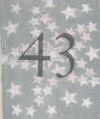 |
Learn more about rare star counts.
Some star counts are common, others are
exceptionally rare. Find out about
which are the rarest and why. |
|
 |
Learn more about printed parade flags.
Printed parade flags have been produced
since the 1830s. Unlike their
pieced-and-sewn brethren, printed flags
designed for waving at parades and
hanging at patriotic gatherings have a
character all their own. |
|
 |
Learn more about methods of creating
stars.
The methods for applying stars
to a flag are varied and interesting.
Different techniques change the
character of the flag, and add yet
another element to the great variability
in American flags. |
|
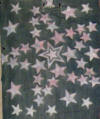 |
Learn more about the Grand Luminary
pattern.
The "Great Star", or "Grand
Luminary", is one of the rarest and most
visually exciting patterns present on
the American flag. See various
examples and learn about the history of
this pattern. |
|
 |
Learn more about the Medallion pattern.
Another of the great patterns of stars
on American flags is the Medallion
pattern. See various examples and
learn the history of this pattern. |
|
 |
Learn more about the presence of writing
on American flags.
Whether hand
written or printed, writing on American
flags is a historical curiosity that
provides intriguing and precise context
to a flag's history. |
|
 |
Learn more about classifications of star
patterns.
The patterns of stars
found on American flags are virtually
limitless, but there are certain
classification categories that are often
used to generally characterize the star
pattern of a flag. |
|
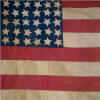 |
Learn more about
Liberation Flags.
These flags
produced in Europe to celebrate
liberation during World War II are a
fascinating subset of historic American
flags. |
|
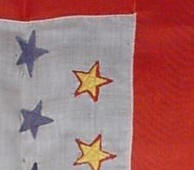 |
Learn more about Son In Service Banners.
Son In
Service banners, prevalent during World
War I and World War II, are a poignant
and enduring symbols of service to the
nation and those who sacrifice their
life defending America. |
|
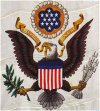 |
Learn more about
Executive Flags.
The
Executive Flags of the United States are
official flags designated to represent
particular offices in the executive
branch, most notably, the President of
the United States. |
|
 |
Learn more about
Flag Restoration.
Great
flags are not always found in great
shape. That shouldn't dissuade
collectors from acquiring them and
working to preserve them.
Restoration is an important part of
collecting. |
|
 |
Learn more about the Parts of a Flag
Flag
collectors talk about the parts of flags
using certain terminology. This guide
will help you understand the meaning and
proper usage of common terms used to
describe flags and their attributes. |
|
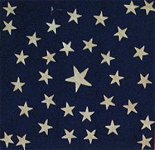 |
Learn
about Center Stars
These
large stars represent the newest state
to enter the Union and add great
character and boldness to flags of all
eras. |
|
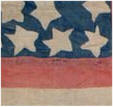 |
Learn
about the Blood Stripe
When the
canton of a flag rests upon a red
stripe, it's said to fall on the "blood
stripe". Flag folklore holds that this
trait symbolizes our nation at war. |
|
 |
Learn
about the Advertising Trade Cards
These rare
and beautifully graphic cards, popular
in the late 19th century, are
interesting examples of how American
business owners around the country use
the American flag to advertise their
goods and services. |
|
|
|
|
 |
|
|
|
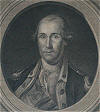 |
Learn about the Engraved Portraits of
George Washington
Engravings
of George Washington are prolific in our
national culture and those that date to
his lifetime in the last quarter of the
18th century are especially sought after
by collectors of early patriotic
Americana. |

